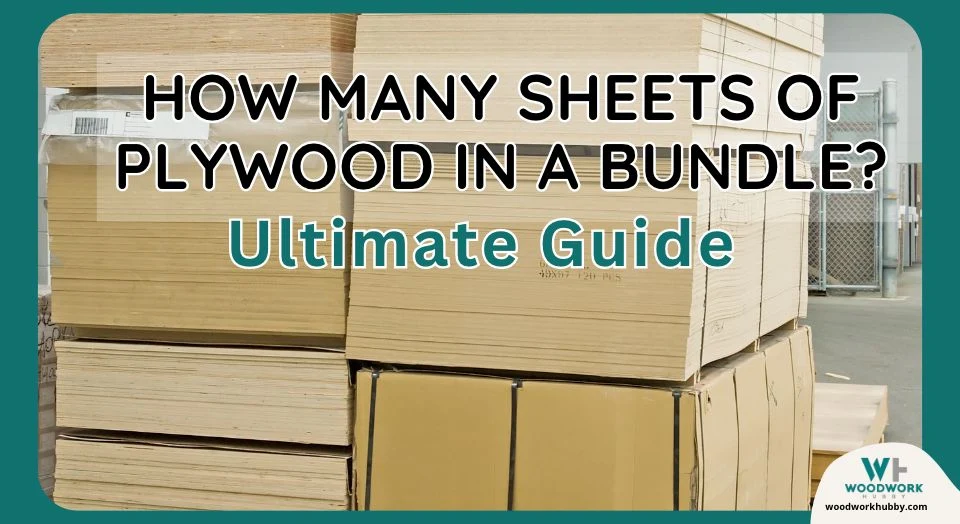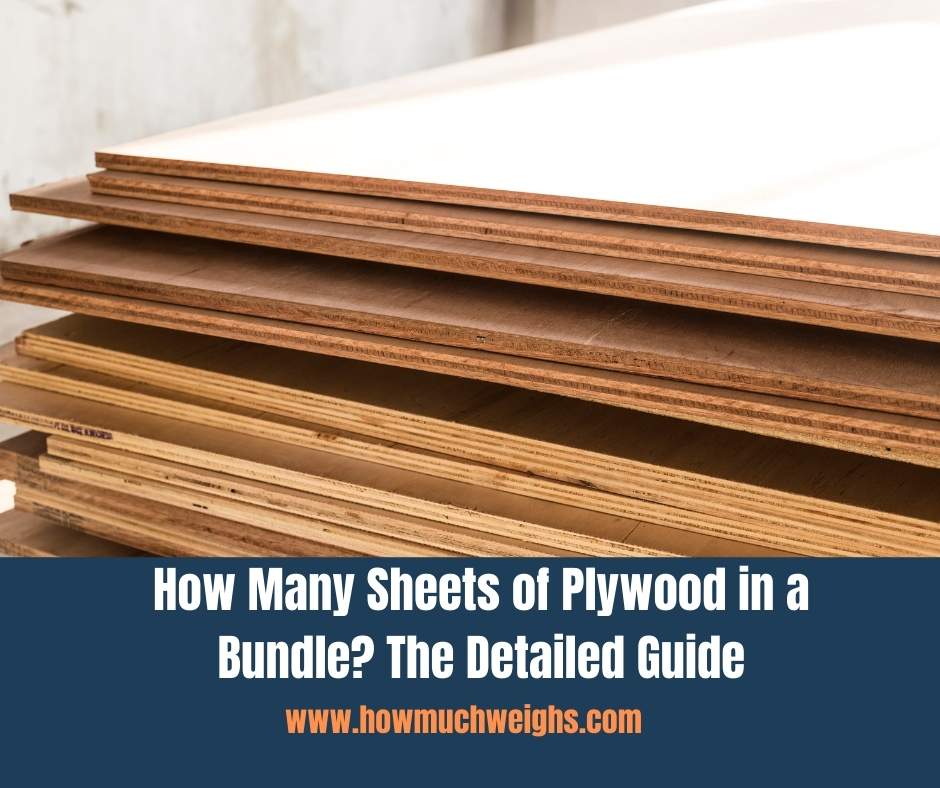Are you wondering how many sheets of plywood come on a pallet? Well, let’s dive right in and find out! Plywood is a versatile material used in various construction and DIY projects, and knowing how it’s packaged can be helpful when planning your projects.
When it comes to plywood pallets, the number of sheets can vary depending on the size and thickness of the plywood. Pallets typically come in standard sizes, and the number of sheets on a pallet can range from around 50 to over 100 sheets.
Now, you might be thinking, “Why does the number of sheets vary?” It’s because plywood sheets come in different sizes and thicknesses. Thicker sheets are heavier and take up more space, so fewer of them can fit on a pallet compared to thinner sheets. So, it’s essential to consider the specific dimensions and thickness of the plywood you’re working with to determine how many sheets come on a pallet.
In this article, we’ll explore the factors that determine the number of sheets on a plywood pallet, including the dimensions and thickness of the sheets. So, let’s roll up our sleeves and get ready to uncover the secrets of the plywood pallet packaging world!

How Many Sheets of Plywood Come on a Pallet?
When it comes to construction and woodworking projects, plywood is a versatile and widely used material. But if you’re planning a large-scale project or buying plywood in bulk, you may be wondering how many sheets of plywood come on a pallet. Understanding the quantity you can expect can help you plan your project and ensure you have enough materials on hand. In this article, we’ll explore the typical number of plywood sheets you can expect to find on a pallet, as well as some factors that may affect this number.
Factors That Influence the Number of Plywood Sheets on a Pallet
While the exact number of plywood sheets on a pallet can vary depending on several factors, there are a few key considerations to keep in mind:
The Size and Thickness of the Plywood Sheets
The size and thickness of the plywood sheets play a significant role in determining the number of sheets that can fit on a pallet. Standard plywood sheets typically measure 4 feet by 8 feet, but you may also find other sizes such as 4 feet by 4 feet or 2 feet by 4 feet. Additionally, plywood comes in various thicknesses, ranging from 1/8 inch to 3/4 inch. Thicker plywood sheets may take up more space and result in fewer sheets on a pallet.
The size and thickness of the plywood sheets can also affect the weight of the pallet. It’s important to consider the weight capacity of your vehicle or equipment if you’re transporting the pallet, as well as any weight limitations at your desired storage location.
Supplier Packaging and Standards
Each supplier may have their own packaging guidelines or standards for palletizing plywood. Some suppliers may maximize the number of sheets per pallet to optimize shipping and storage efficiency, while others may prioritize product protection and packaging stability. Factors such as the type of pallet used, the arrangement of the sheets, and the use of securing materials like shrink wrap or straps can all impact the number of sheets on a pallet.
Equipment and Handling Capabilities
The handling and transportation equipment available to you or your supplier can also influence the number of plywood sheets on a pallet. Forklifts, pallet jacks, and other equipment have load weight and size limitations that may affect how many sheets can be safely stacked on a pallet. It’s essential to consider these limitations to ensure the pallet can be easily moved and transported without any safety risks or damage to the plywood sheets.
Calculating the Number of Plywood Sheets on a Pallet
While there isn’t a one-size-fits-all answer to how many sheets of plywood come on a pallet, you can calculate an estimate based on some general guidelines. Keep in mind that these numbers can vary depending on the factors mentioned earlier.
Standard 4×8 Feet Plywood Sheets
If you’re dealing with standard 4 feet by 8 feet plywood sheets, a common pallet configuration consists of stacking 4 feet by 8 feet sheets in a grid pattern, with each layer consisting of 50 sheets. This arrangement allows for 100 sheets on a single pallet, with two layers of 50 sheets each.
However, please note that the height of the pallet may be limited by handling and transportation equipment. While each layer may typically hold 50 sheets, the number of layers that can be safely stacked may vary depending on the thickness and weight of the plywood.
Alternative Plywood Sizes and Arrangements
If you’re working with plywood sheets of different sizes, such as 4 feet by 4 feet or 2 feet by 4 feet, the number of sheets per pallet may vary. It’s best to consult with your supplier or check the packaging guidelines to determine the specific number of sheets in these cases.
Additionally, some suppliers may choose alternative arrangements, such as stacking the sheets vertically instead of horizontally, to maximize storage space or accommodate specific handling requirements. These variations can impact the number of sheets on a pallet and should be considered when making your calculations.
Tips for Palletizing and Transporting Plywood
When palletizing and transporting plywood, it’s important to take proper precautions to protect the sheets and ensure their safe arrival at their destination. Here are some tips to consider:
Secure the Plywood Sheets
Use shrink wrap, straps, or bands to secure the plywood sheets to the pallet. This will prevent shifting or sliding during transportation, reducing the risk of damage.
Protect the Sheets from Moisture
If the plywood will be exposed to the elements during transport or storage, consider covering the pallet with a waterproof tarp or plastic wrap to protect the sheets from moisture damage.
Use Appropriate Lifting Equipment
Ensure that the handling equipment used to move and transport the pallet is appropriate for the weight and size of the load. Using equipment with insufficient lifting capacity can be dangerous and lead to accidents or damage to the plywood sheets.
By following these tips and considering the factors that influence the number of plywood sheets on a pallet, you can efficiently plan your projects and ensure a smooth and successful construction process. Whether you’re a contractor, DIY enthusiast, or supplier, understanding the logistics of palletized plywood can help you make informed decisions and optimize your operations.
Key Takeaways: How Many Sheets of Plywood Come on a Pallet?
– On average, there are 50 to 60 sheets of plywood on a standard pallet.
– The number of sheets can vary depending on the thickness and size of the plywood.
– It is essential to check the specific measurements and weight capacity of the pallet to ensure safe transport.
– Plywood sheets are stacked and secured on a pallet to maximize space and prevent damage during shipment.
– Before purchasing plywood, consider the number of sheets you need and the pallet size to ensure efficient delivery.
Frequently Asked Questions
When it comes to plywood, understanding how it is packaged can be helpful in planning your projects. Here are some common questions regarding the number of sheets of plywood that come on a pallet:
1. How many sheets of plywood are typically on a pallet?
On average, a standard pallet of plywood contains 50 to 60 sheets. However, the exact number can vary depending on the size and thickness of the plywood sheets. Thinner sheets, like 1/4-inch, are often packed in greater quantities than thicker sheets.
Additionally, it’s important to note that different suppliers and manufacturers may have slightly different packaging practices. Some pallets may contain fewer sheets, while others may have more, so it’s always a good idea to check with the specific supplier or retailer.
2. Are the plywood sheets stacked vertically or horizontally on the pallet?
Plywood sheets are typically stacked horizontally on a pallet. This means that the long sides of the sheets are parallel to the ground, making it easier to load and unload the pallet. The sheets are usually tightly packed together to maximize the space on the pallet and ensure stability during transportation.
Stacking the sheets horizontally also helps protect the edges and corners from damage. It prevents the sheets from sagging or bending under the weight of other sheets on top, ensuring that they remain flat and intact.
3. Can I request a specific number of sheets on a pallet when making a purchase?
While it’s not common to request a specific number of plywood sheets on a pallet, you can always communicate with the supplier or retailer to discuss your requirements. They may be able to accommodate your needs, especially for larger orders or specific projects that require a certain quantity of plywood.
However, keep in mind that the packaging is often standardized to meet industry practices and transportation regulations. Altering the number of sheets on a pallet may affect the efficiency of logistics and potentially increase the cost of shipping.
4. How much does a pallet of plywood weigh?
The weight of a pallet of plywood can vary depending on the thickness and type of plywood, as well as the specific dimensions of the sheets. On average, a standard pallet of plywood weighs between 1,200 and 2,000 pounds. Thicker and larger sheets will contribute to a higher overall weight.
It’s important to consider the weight of a pallet when planning transportation or storage. Ensure that the load capacity of vehicles, forklifts, or shelves can handle the weight to prevent accidents or damage.
5. Can I purchase individual sheets of plywood instead of a whole pallet?
Yes, you can typically purchase individual sheets of plywood instead of a whole pallet. Many suppliers and retailers offer the option to buy plywood by the sheet, allowing you to only purchase the amount you need for your specific project. This is especially useful for smaller-scale DIY projects or when you only require a few sheets.
However, keep in mind that purchasing individual sheets may be more expensive per sheet compared to buying in bulk as part of a pallet. It’s always a good idea to compare prices and consider the quantity you need to make the most cost-effective decision.

Summary
Ever wondered how many sheets of plywood are on a pallet? Well, the answer depends on the thickness of the plywood. For 1/4-inch thick plywood, there are usually around 100 sheets on a pallet. Thicker plywood, like 3/4-inch, usually has around 40 to 50 sheets on a pallet. So, it all comes down to the thickness!
But why does the thickness matter? Thicker plywood takes up more space and is heavier, so fewer sheets fit on a pallet. Thinner plywood, on the other hand, is lighter and takes up less space, allowing more sheets to be stacked together. So, next time you see a pallet of plywood, you can impress your friends with your knowledge of how many sheets are on it!
